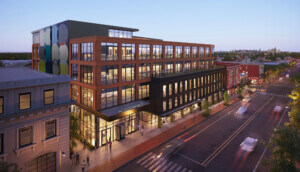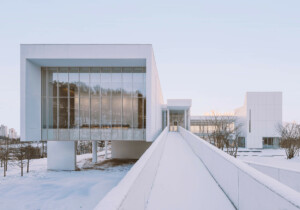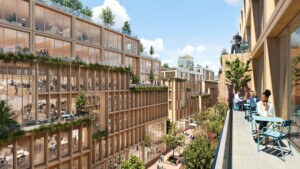Who could possibly make Richard Meier work in anything but white?
Someone with a good plan and a strong vision (well, also this guy). Deep in downtown Newark, New Jersey, Richard Meier & Partners, working for developer RBH Group, has put another round of finishing touches on a multi-building development called Teachers Village. Though technically “mixed-use,” the Teachers Village spirit is more in line with a cheery contemporary mill town, or a little Columbus, Indiana. In a postindustrial twist, the project’s affordable and market-rate residences were marketed first towards teachers and their families (though other workers are welcome, too).
The complex’s three apartment buildings by Meier feature 123 residential units. Each unit is sunny, owing to the ring of (to-be-developed) surface parking surrounding much of the Village and to the floor-to-ceiling windows in the common spaces. The scheme has proved popular so far—as of mid-February, the buildings are almost fully leased.
Some of the residents teach at the development’s three charter schools (two designed by Meier). On a recent tour, reporters ascended an outdoor stair on a skywalk between the two schools, topped by a few circular skylights, and filed along a catwalk above the spacious gymnasium. After school hours, residents can play basketball on the indoor courts, which barely need overhead lighting thanks to ecclesiastic south-facing windows.
RBH Group wanted the project to integrate with Newark’s beautiful but worn streets nearby. The design team worked with the city’s Landmarks & Historic Preservation Commission to envision structures that would reflect Newark’s scale and vernacular. The result: Meier used red brick for the first time since the 1960s.
Well, not true red brick. The material, used on one of the schools, is inflected with iron, projecting a soft metallic glow in the right light, a still-earthy foil to white aluminum panel– and stucco-clad buildings nearby. Some of the window-adjacent brick is arranged in a sawtooth pattern, establishing visual continuity with the low-slung commercial storefronts nearby detailed with decorative brick and terra-cotta tiles.
This is deeply intentional. Teachers Village harmonizes with the surrounding city, but it’s more than a patch in the urban fabric. The project on target to receive LEED Neighborhood Development certification, a hard-to-get designation awarded to community-scale projects that evince sustainable design and smart urban development. Lined with street-level retail, buildings along the Halsey Street corridor are not more than four stories tall, in keeping with Newark’s low-rise character and growth goals outlined in the latest master plan. Teachers are less than a 15-minute walk to the nearest PATH and NJ Transit stations, near the Prudential Center and three city parks.
All told, the six buildings of Teachers Village’s first phase include three schools, 65,000 square feet of retail, and residential programs spread out over 23 acres south of Market Street and west of Broad Street. The development is part of what could be, by 2050, a 15 million-square-foot development with a 200-room hotel, 550,000 square feet of retail and cultural programming, 4.75 million square feet of office space, and up to 8,000 residential units. The project broke ground in 2012, and buildings have been coming online for the past four years. A mix of residential and retail, Building VI (243 Halsey Street) has just recently opened its doors to new tenants.
“Newark doesn’t have the best reputation,” said Meier, who was born in the city. “It needs this kind of development to help others realize that Newark’s an important city. Any project we can do to help the whole city—we’re proud to do it.”
Editor’s Note: This article initially stated that 206 units were constructed in Phase One. There are 123. In addition, the article was updated to include the project’s overall development capacity.










